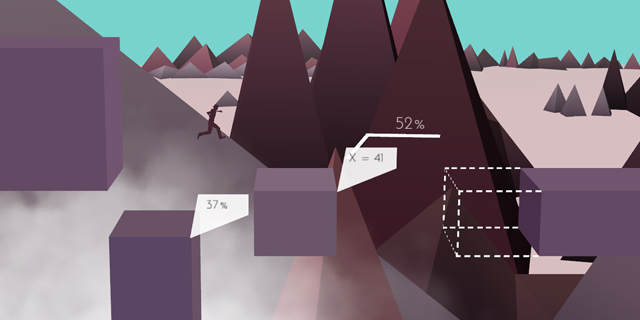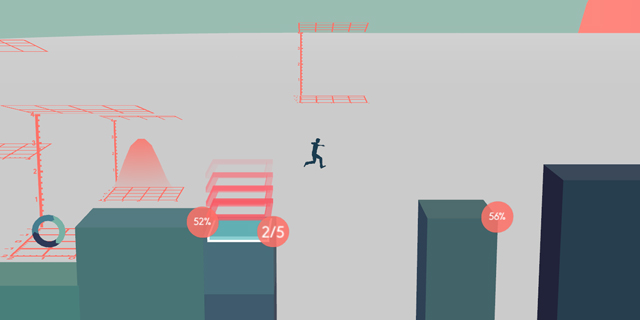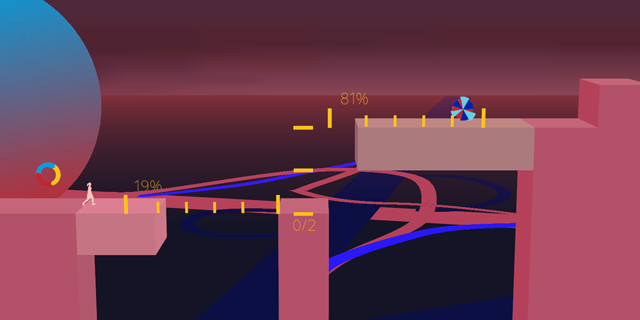
The world of data visualization is in many ways a novel one for games. I mean, to a certain extent, all games are is data visualization, but it’s never really drawn inspiration from these infographics precepts in a significant way. Metrico developer Digital Dreams saw that hole in its own data and sought to fill it with a game that is both visually arresting and mentally demanding.
There’s no denying that Metrico is a very, very pretty game. The Pub Fund title’s Vita exclusivity means it can take advantage of that detailed, vibrant display to add definition to generally-straightforward polygonal environments, and it follows in the footsteps of games like Sound Shapes in making things stylish through simplicity. It enhances its rather-simple foreground with dynamic backdrops, each world’s adding to a different aspect of the infographics aesthetic. Keeping to simple palettes allows Metrico to completely swap the palette out from level to level, while the geometry ties the collected experience together.
The focus on the world around you becomes very obvious when you see the person you’re playing. Or, well, don’t. Metrico sports what is likely the smallest controllable character in the history of platformers, a silhouetted person (of whichever gender you prefer) whose normal human proportions lead to a width of about six pixels at times. This isn’t usually a problem with solid backgrounds and a well-distinguished palette, but definitely be prepared to keep a vigilant eye on yourself as the game starts to get tricky.

Metrico‘s aesthetic certainly leans into the idea of business-style infographics, but the mechanics associated with these obstacles and platforms will appeal much more to people who like the idea of exploring programming and variables. Bars will grow and shrink and blocks will move based on really any of the variables you can think of. Some use tilt functions, some keep track of running and jumping time or distance and some trigger on dispatching enemies or landing on specific panels. It’s all about experimentation, with a healthy dose of manual dexterity from time to time as the mechanics ask more and more of you as you progress.
In many ways, Metrico is a great showpiece for the Vita itself. Though the time for something like that as a way to sell hardware may have passed, those who already have the system will be more than happy to see a developer still putting effort into fulfilling the promise of the Vita’s exclusive features, and doing it in a way that doesn’t feel like a tech demo or a forced, gimmicky implementation for novelty’s sake.
Success in the game hinges on recalling and using all of the system’s capabilities, and sometimes it can get brutal in this pursuit. Once the game is out there for a bit, you’ll be able to look up solutions to tricky segments, but if you like playing purely on your own wits, you’re assisted only by the knowledge that everything you need to manipulate to progress is on the screen at any given moment.

I’m trying to be as vague as possible about the puzzles themselves, since figuring out just how to control everything on the screen in a given puzzle is the most engaging part of Metrico. There are some elements of the adventure that even go unexplained after you’ve completed the game, making me genuinely curious if any further revelations are ahead.
While Metrico isn’t particularly long or at all forgiving, there’s definitely more beneath the surface here, and when I’m not replaying it in front of people to show just what the Vita can do, I can see myself trying to explore every little nook of the game’s challenges. It’s a game with both unrivaled style and undeniable substance, and you can’t ask for more than that.
Pros: Innovative mechanics, good use of hardware, well-executed aesthetic
Cons: Sometimes-brutal puzzles, limited length, the tiniest platformer character of all time



















